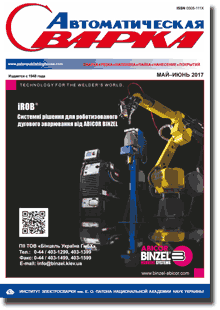| 2017 №06 (16) |
DOI of Article 10.15407/as2017.06.17 |
2017 №06 (01) |

Avtomaticheskaya Svarka (Automatic Welding), #6, 2017, pp. 105-107
Application of differential-taylor transformation for modeling processes in resonance power sources
I.V. Vertetskaya and A.E. Korotynsky
E.O. Paton Electric Welding Institute, NASU 11 Kazimir Malevich Str., 03680, Kiev, Ukraine. E-mail: office@paton.kiev.ua
Abstract
To model electrical processes in resonance-type arc welding sources, it was proposed to use differential-Taylor transformation, which essentially simplifies computational procedures for analysis of the modes and determination of the main parameters of the secondary circuit. The essence of this method consists in conversion of the time continuous function of the original into the image function from discrete argument, the coefficients of which are called discretes. The accuracy of the derived results is determined by the number of discretes used at the stage of image analysis. 6 Ref., 1 Figure.
Keywords: original, image, differential-Taylor transformation, DT-model, resonance source
Received: 26.10.17
Published: 06.07.17
References
- Pukhov, G.E. (1986) Differential transformations and mathematical modeling of physical processes. Kiev: Naukova Dumka.
- Lebedev, V.K., Narushkyavichus, I.R. (1971) Stability of alternating current arc burning in circuit with capacitor. Svarka, 4, 3–5.
- Lebedev, V.K., Korotynsky, A.E. (1994) Alternating current arc in circuit with inductance and capacitance connected in-series. Ibid., 12, 47–48.
- Atabekov, G.I., Kupalyan, S.D., Timofeev, A.B. et al. (1979) Nonlinear electric circuits. Moscow: Energiya.
- Mun, F. (1990) Chaotic oscillations. Moscow: Mir.
- Golovin, E.D. (2004) Mathematical and numerical modeling of nonlinear devices and devices with alternating parameters: Syn. of Thesis for Cand. of Techn. Degree. Tomsk.
